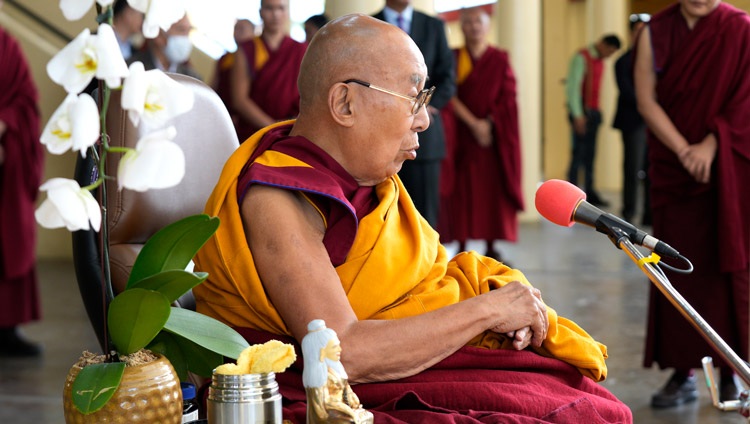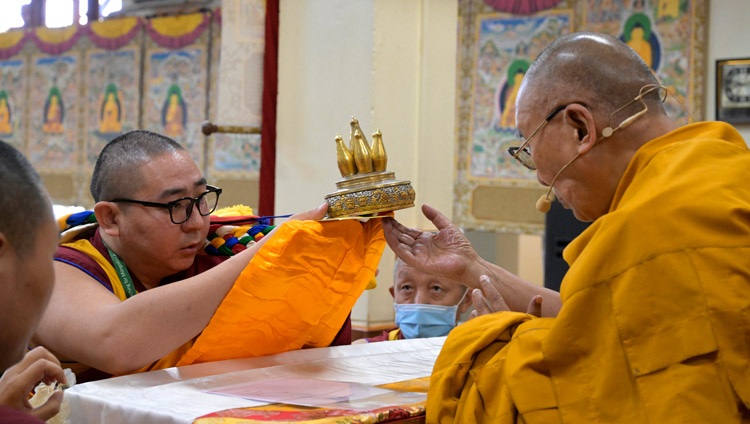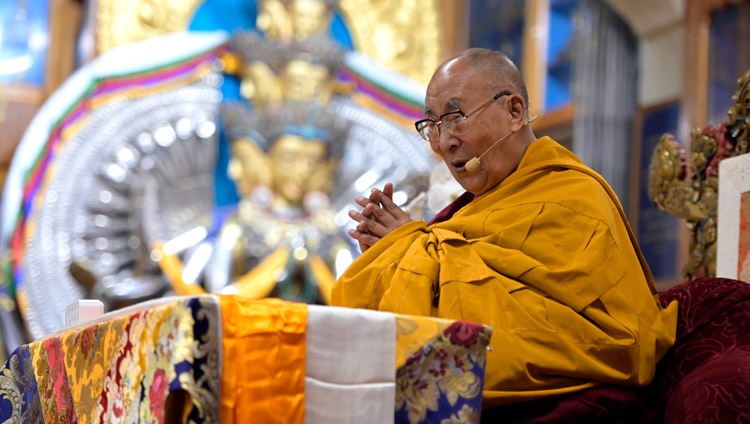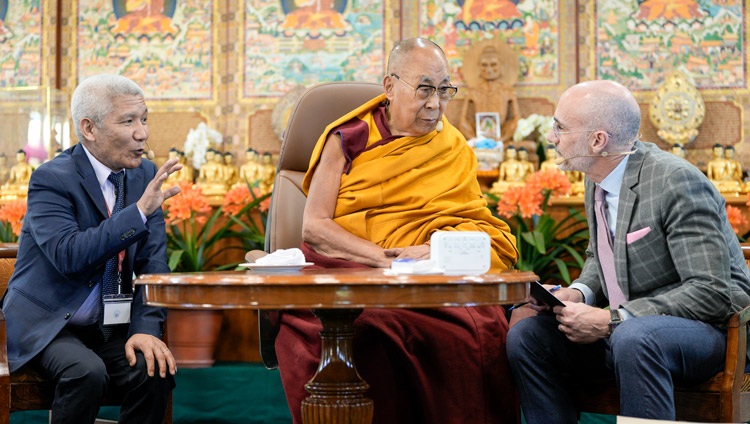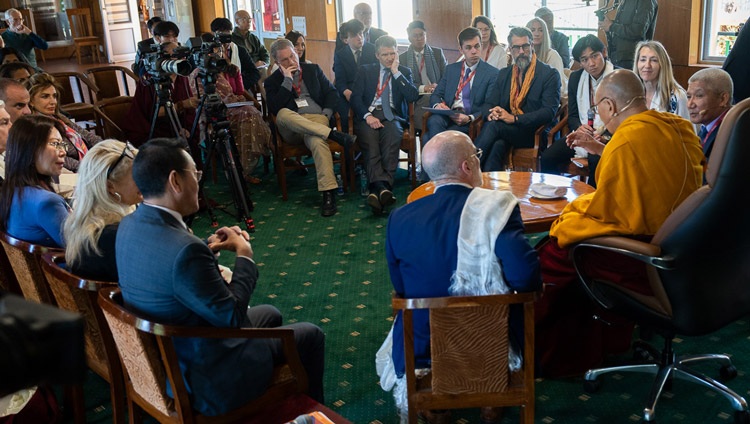The Four Noble Truths and the Two Truths
April 7, 2021
Thekchen Chöling, Dharamsala, HP, India – This morning His Holiness the Dalai Lama saluted his online hosts, the Italian Buddhist Union, and took his seat. The session began immediately with a recitation of the ‘Heart Sutra’ in Italian. When that was complete, President of the Italian Buddhist Union, Filippo Scianna extended a welcome to His Holiness on behalf of the Union. that he explained includes members from a wide range of Buddhist traditions. Besides their interest in Buddhism, members provide humanitarian aid where it is needed and cultivate friendly relations with other religious traditions. He declared that His Holiness is their source of inspiration and requested him to teach.
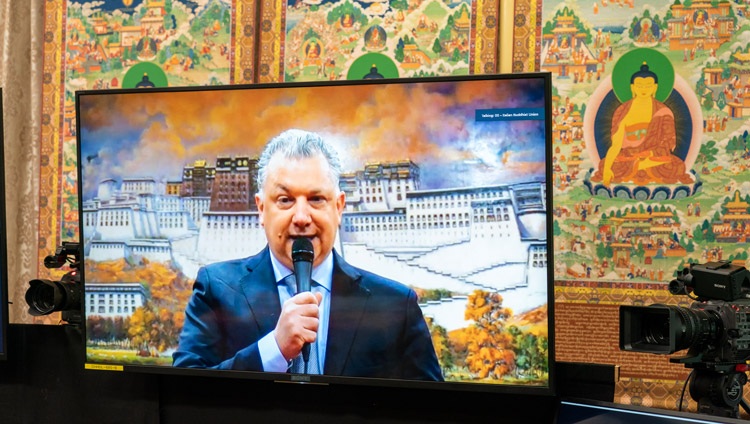
“Today, you Italians have asked me to talk about the Four Noble Truths and the Two Truths,” His Holiness responded. “There are many different religious traditions in the world. They may differ from a philosophical point of view, but they share a common message about the importance of love and compassion. In India, the practice of ‘ahimsa’, non-violence or non-harm, and ‘karuna’, compassion, have flourished over the last 3000 years or so. What’s more, in India, all the world’s major religions live together peaceably side by side.
“Since better contact has been achieved between East and West, more and more people have taken an interest in Buddhist teachings belonging to both the Pali and Sanskrit Traditions.
“When Shantarakshita was invited to Tibet by King Trisong Detsen, he introduced the Nalanda Tradition. He was a great master of philosophy as well as logic and epistemology, as revealed in two books he wrote: ‘A Compendium of Reality’ (Tattvasamgraha) and the ‘Ornament of the Middle Way’ (Madhyamakalalamkara).
“Since the eighth century Tibetans have followed Madhyamaka or Middle Way philosophy through logic and reason. In so doing they took inspiration from the Buddha who counselled, “As the wise test gold by burning, cutting and rubbing it, so, bhikshus, should you accept my words—only after testing them—and not merely out of respect for me.” Because our tradition is based on logic and reason, today, even interested scientists can relate to it.
“The Four Noble Truths are the foundation of the Buddha’s teaching. However, immediately after his enlightenment he is reported to have said:
“Profound and peaceful, free from complexity, uncompounded luminosity—
I have found a nectar-like Dharma.
Yet if I were to teach it, no-one would understand,
So, I shall remain silent here in the forest.
“But when he encountered his five former companions, and they requested him to teach, the Four Noble Truths are what he taught them.
“According to the Sanskrit Tradition, the Buddha turned the wheel of dharma three times—three rounds of teaching. The first concerned the Four Noble Truths, which he disclosed in terms of nature, function and result. When he explained their nature, he declared that suffering is to be known, its origin is to be eliminated, and cessation is to be actualized by cultivating the path. And the origin to be eliminated was karma and mental afflictions, which, in addition to selflessness, were explained in greater detail in the second and third rounds of teachings.
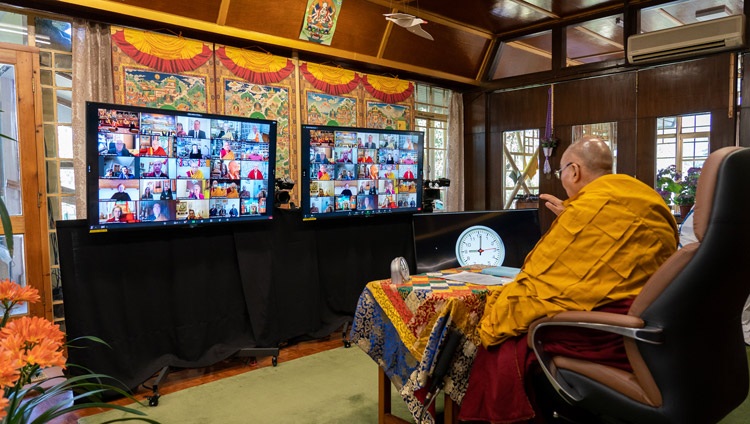
“With regard to their result, the Buddha stated that suffering must be known and yet there is nothing to be known. Karma and mental afflictions are to be overcome, but there is nothing to be overcome.
“We can understand the words, ‘profound and peaceful’ in the verse I quoted above to refer to the first round of the Buddha’s teachings and the Four Noble Truths. ‘Free from complexity’ indicates the perfection of wisdom of the second round. ‘Uncompounded luminosity’ relates to the content of the Buddha’s third round of teachings, especially Buddha nature and the ‘Tathagatagarbha-sutra’. During the second round he dealt with the object clear light, which refers to emptiness, while in the third round he alluded to the subjective clear light—the mind of clear light.
“Mental afflictions are distorted conceptions. Nagarjuna explained that the ignorance that is at their root refers to the misconception that things have true existence. His disciple Aryadeva pointed out that ‘as the tactile sense [pervades] the body, ignorance is present in all [mental afflictions]. By overcoming ignorance, you will also overcome all mental afflictions.’ He remarked that ignorance can be eliminated by understanding dependent arising.”
His Holiness acknowledged that it is because of Shantarakshita that Tibetans follow the Buddha’s teaching in reliance on logic and reason. He noted that this makes aspects of the Buddha’s teaching, particularly in relation to the workings of the mind, accessible to scientists. This is relevant because there is a growing understanding that talk about peace in the world will only be fulfilled when individuals have cultivated peace of mind within themselves.
A proper understanding of the Four Noble Truths depends on understanding the Two Truths. In this connection His Holiness referred to verses from Chandrakirti’s ‘Entering into the Middle Way’.
And just as from an empty thing like a reflection
a perception can arise that bears its form, 6.37
likewise, although all things are empty,
they do arise from emptiness in a robust way.
Since no intrinsic nature exists in either of the two truths,
phenomena are neither eternal nor annihilated. 6.38
Since actions do not cease in an intrinsic manner,
they remain potent even in the absence of a foundation consciousness.
Indeed, in some cases, the acts themselves may have long ceased,
yet their effects will come about without fail; this you should know. 6.39
What this indicates is that although the independent existence of things cannot be found under scrutiny, they do exist by way of convention or designation. An ignorant misconception of the true or intrinsic existence of things can be eliminated by understanding emptiness. When you understand that cessation can be achieved within yourself, you will be able to verify this truth from your own experience.
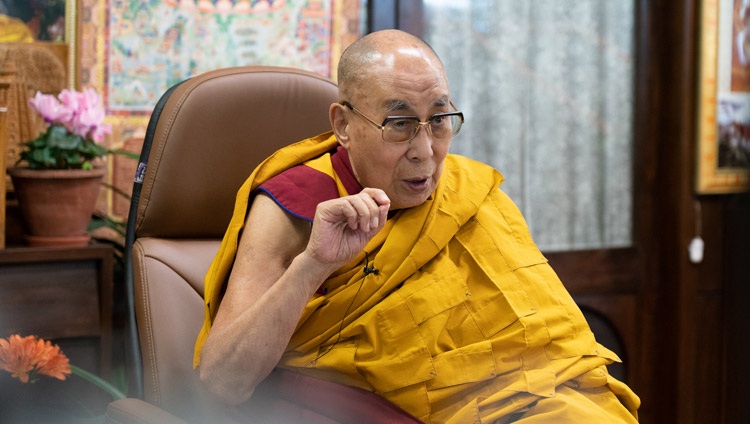
His Holiness cited verses from the end of chapter six of ‘Entering into the Middle Way’ that shed light on conventional and ultimate truth, finally likening them to the wings on which the king of swans flies to the far shore. He encouraged his listeners to listen, reflect and develop experience of these truths within themselves.
Thus, illuminated by the rays of wisdom’s light,
the bodhisattva sees as clearly as a gooseberry on his open palm
that the three realms in their entirety are unborn from their very start,
and through the force of conventional truth, he journeys to cessation. 6.224
Though his mind may rest continuously in cessation,
he also generates compassion for beings bereft of protection.
Advancing further, he will also outshine through his wisdom
all those born from the Buddha’s speech and the middle buddhas. 6.225
And like a king of swans soaring ahead of other accomplished swans,
with white wings of conventional and ultimate truths spread wide,
propelled by the powerful winds of virtue, the bodhisattva would cruise
to the excellent far shore, the oceanic qualities of the conquerors. 6.226
His Holiness reiterated the importance of understanding the Buddha’s teaching in the light of reason and logic. He mentioned the popular saying that compares the Madhyamaka or Middle Way view and reason and logic to two lions yoked together at the neck. These two traditions were introduced by Shantarakshita and Tibetan masters like Chapa Chökyi Sengé (1109-69), the Abbot of Sangphu, later formalized the Tibetan mode of debate.
When answering questions from the virtual audience His Holiness touched on the Bön tradition that existed in Tibet prior to the arrival of the Jowo statue of Buddha Shakyamuni in Lhasa, brought by the Chinese princess who married King Songtsen Gampo. Later, Shantarakshita encouraged King Trisong Detsen to translate Indian Buddhist literature into Tibetan. Buddhism took root, but the Bön tradition survives today.
Although people in the West are showing interest in Buddhism these days, it’s important that the prevailing Judeo-Christian traditions continue to be accorded respect. His Holiness emphasized again that all religious traditions teach the importance of ethics and compassion.
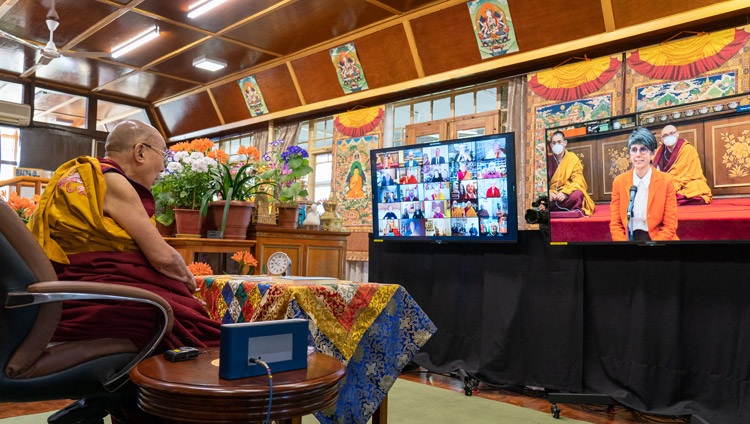
His Holiness observed that the Buddha embraced the homeless life. Many of his followers did likewise. The foundation of their practice was the Vinaya and its precepts. He noted that if you can keep the vows, well and good, but it is not necessary to do so to be a warm-hearted person.
Regarding what the future of Buddhism may be over the next fifty years, His Holiness said it was difficult to say. The era of the previous Buddha, Kashyapa, came to an end. Buddha Shakyamuni’s teachings presently continue to flourish. However, the threat that global heating poses simply to water supplies means the future is not guaranteed.
Asked about the arising of destructive emotions His Holiness explained that we develop attachment and aversion to things because they appear to exist solidly from their own side. When we realize that they actually depend on other factors and conditions and are not as they appear, we react to them differently.
Quantum physics also states that things do not exist as they appear, but it also seems to challenge their external existence. This is reminiscent of the Mind Only contention that objects and the subjective perceiving mind are of the same nature. This view may loosen the grip of mental afflictions, but it’s necessary to realize the Consequentialist view that things have no independent existence whatsoever—they are mere designations—to uproot ignorance.
His Holiness advised that suffering can be transformed into an aspect of the path, in particular to the practice of bodhichitta by wishing that through this suffering our negativities may be purified. He cited a verse from the Guru Puja:
Therefore, O venerable compassionate gurus,
Bless me that all the obstructions from misdeeds, and sufferings
Of mother beings ripen upon me right now,
And that I may give my happiness and virtues to others
In order that all sentient beings have bliss.
He stressed that another aspect of bodhichitta, humility, expressed as regarding yourself as inferior to others, is not a matter of being despondent. Since it is linked to the wish to lead beings from across the expanse of space to enlightenment it reflects great courage. As the practice of cherishing others is strengthened it gives rise to such courage, which in turn reinforces great compassion. When you have great compassion, you’ll have the fortitude to help others overcome their sufferings.
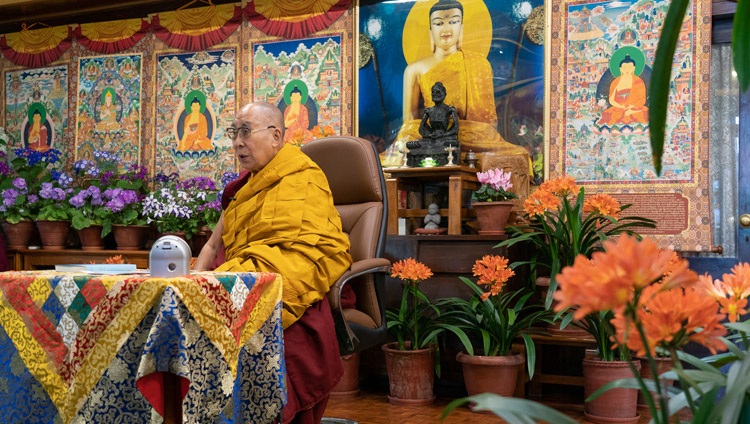
Invited to compare the nirvana of an Arhat the truth body of a Buddha, His Holiness clarified that whereas for an Arhat who has overcome mental afflictions, obscurations to knowledge remain, the Buddha has eliminated them all.
Asked to recommend verses that aid the understanding of emptiness, His Holiness cited one from Nagarjuna’s ‘Fundamental Wisdom of the Middle Way’,
Through the elimination of karma and afflictive emotions there is liberation.
Karma and afflictive emotions come from conceptual thoughts.
These come from mental fabrication.
Fabrication ceases through emptiness,
He also mentioned several verses from chapter six of Chandrakirti’s ‘Entering into the Middle Way’,
If the intrinsic characteristics of things were to arise dependently,
things would come to be destroyed by denying it;
emptiness would then be a cause for the destruction of things.
But this is illogical, so no real entities exist. 6/34
Thus, when such phenomena are analyzed,
nothing is found as their nature apart from suchness.
So, the conventional truth of the everyday world
should not be subjected to thorough analysis. 6/35
In the context of suchness, certain reasoning disallows arising
from self or from something other, and that same reasoning
disallows them on the conventional level too.
So, by what means then is your arising established? 6/36
His Holiness disclosed that he regularly repeats these verses to himself and reflects that although things cannot be found under analysis, they do exist by way of convention and designation.
In her brief words of thanks, Giovanna Giorgetti expressed the wish that His Holiness will live long and the hope that he will visit Italy again in person.
His Holiness announced his intention to lead a ceremony for cultivating the awakening mind of bodhichitta. He guided the appropriate visualization of the Buddha and so forth and invited the audience to repeat the standard three verses after him.
Finally, he released the Italian translation of the first volume in the Science and Philosophy in the Indian Buddhist Classics series —The Physical World— and expressed his gratitude to the translator.

